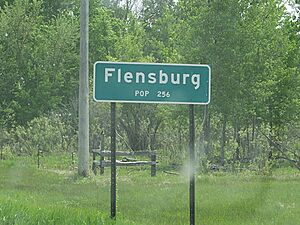Flensburg, Minnesota facts for kids
Quick facts for kids
Flensburg, Minnesota
|
|
|---|---|

Flensburg city sign, 2006
|
|

Location in Morrison County and the state of Minnesota
|
|
| Country | United States |
| State | Minnesota |
| County | Morrison |
| Platted | March 1890 |
| Incorporated | June 17, 1911 |
| Area | |
| • Total | 7.022 sq mi (18.187 km2) |
| • Land | 6.979 sq mi (18.077 km2) |
| • Water | 0.043 sq mi (0.111 km2) |
| Elevation | 1,230 ft (375 m) |
| Population
(2020)
|
|
| • Total | 216 |
| • Estimate
(2022)
|
214 |
| • Density | 30.95/sq mi (11.95/km2) |
| Time zone | UTC−6 (Central (CST)) |
| • Summer (DST) | UTC−5 (CDT) |
| ZIP code |
56328
|
| Area code(s) | 320 |
| FIPS code | 27-21266 |
| GNIS feature ID | 2394770 |
| Sales tax | 7.375% |
Flensburg is a small city in Morrison County, Minnesota, United States. In 2020, about 216 people lived there. It's a quiet place with a rich history tied to the early railroads in Minnesota.
Contents
History of Flensburg
The story of Flensburg began with a railroad. In 1882, the Little Falls and Dakota Railroad was finished. A special side track was built to a mill. This mill was called "Flen's Landing" or "Flynn's Siding." It had a small train station, or depot. The name came from J. C. Flynn, who was a teacher from Little Falls. He also helped build the railroad that passed through the area.
The town of Flensburg was officially planned out in March 1890. Olaf and Dagmar Searle were the ones who did this. A post office opened in 1892. Flensburg became an official city on June 17, 1911.
How Flensburg Got Its Name
The name "Flensburg" became official in 1892. Local newspapers started using it around that time. However, one newspaper article from 1893 said that "Flynn station" changed its name to "Flensburg" on April 1, 1893. The reason for this change wasn't fully explained.
One idea is that the city was named after a German seaport called Flensburg. This city is in Schleswig-Holstein, Germany. But many of the early landowners in the Flensburg area had Polish last names. It seems unlikely they would have chosen a German name for their new town.
Another idea is that "Flensburg" is a shorter version of "Flynnsburg." Since "burg" means "castle" or "town," and the area was already known as "Flen's Landing" or "Flynn Station," naming it Flynnsburg (or Flensburg) would make sense.
Geography of Flensburg
Flensburg is located in the western part of Morrison County. It shares borders with other townships. To the south is Swanville Township. To the north and west is Culdrum Township. Pike Creek Township is to the north and east. The city of Sobieski is to the southeast.
Flensburg is about 9 miles (14 kilometers) west-southwest of Little Falls. Little Falls is the main city and county seat for Morrison County. This means it's where the county government offices are located.
The city of Flensburg covers about 7 square miles (18 square kilometers). Most of this area is land. A small part, about 0.043 square miles (0.111 square kilometers), is water. Several small natural lakes are found within the city limits. These include Prowect Lake, Kuhl Lake, and Larson Lake. They are mostly in the southwest part of the city.
Population of Flensburg
| Historical population | |||
|---|---|---|---|
| Census | Pop. | %± | |
| 1920 | 210 | — | |
| 1930 | 284 | 35.2% | |
| 1940 | 275 | −3.2% | |
| 1950 | 281 | 2.2% | |
| 1960 | 280 | −0.4% | |
| 1970 | 259 | −7.5% | |
| 1980 | 256 | −1.2% | |
| 1990 | 213 | −16.8% | |
| 2000 | 244 | 14.6% | |
| 2010 | 225 | −7.8% | |
| 2020 | 216 | −4.0% | |
| 2022 (est.) | 214 | −4.9% | |
| U.S. Decennial Census 2020 Census |
|||
In 2010, there were 225 people living in Flensburg. These people lived in 84 households. About 53 of these households were families. The population density was about 32 people per square mile.
Many households had children under 18 living with them. Most households were married couples living together. The average household had about 2.64 people. The average family had about 3.43 people.
The average age of people in Flensburg in 2010 was 37.3 years old. About 29% of residents were under 18. About 18% were 65 years or older. The number of males and females was almost equal. About 50.2% were male and 49.8% were female.
See also
 In Spanish: Flensburg (Minnesota) para niños
In Spanish: Flensburg (Minnesota) para niños

